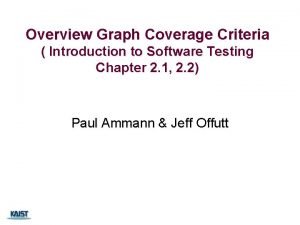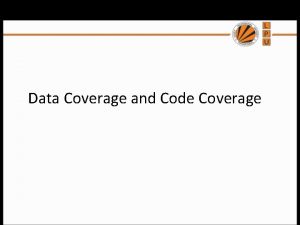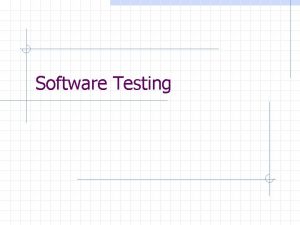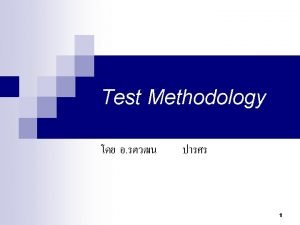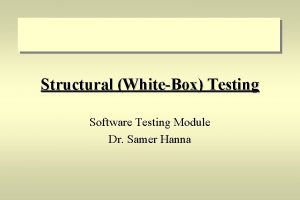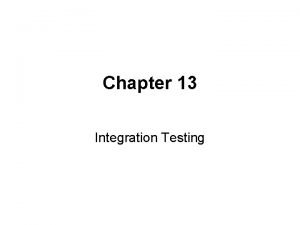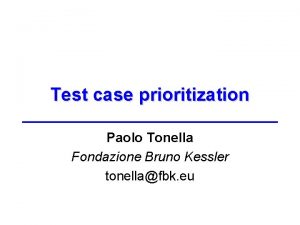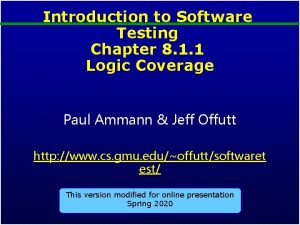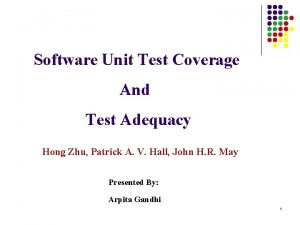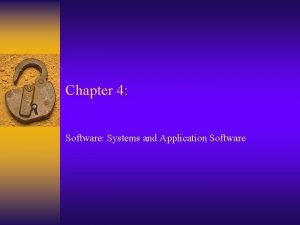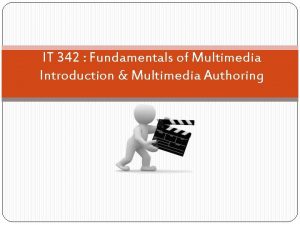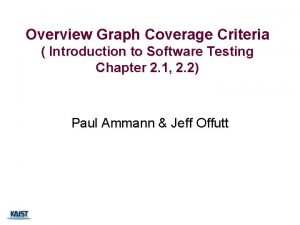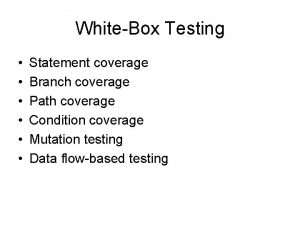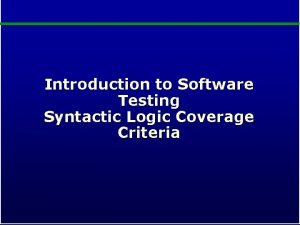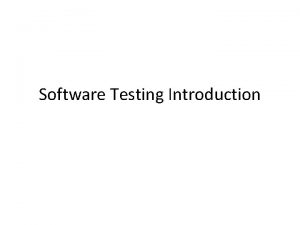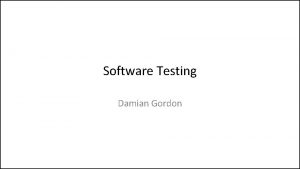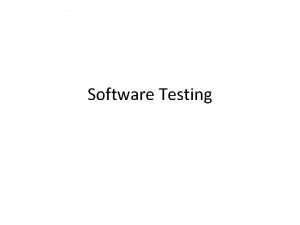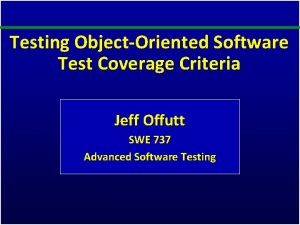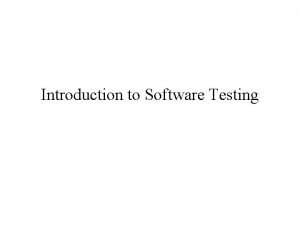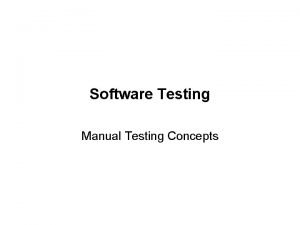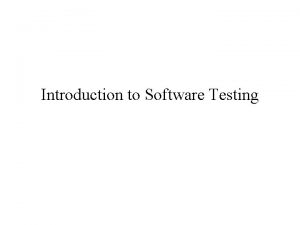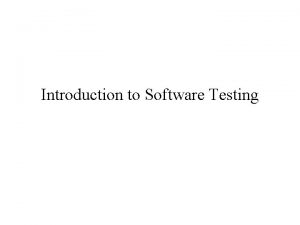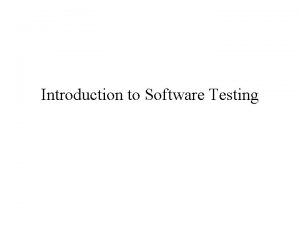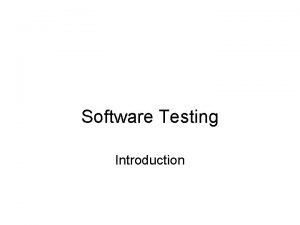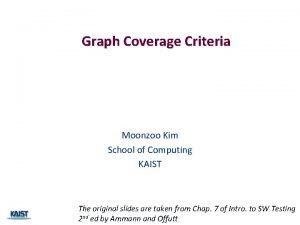Overview Graph Coverage Criteria Introduction to Software Testing
































- Slides: 32

Overview Graph Coverage Criteria ( Introduction to Software Testing Chapter 2. 1, 2. 2) Paul Ammann & Jeff Offutt

Hierarchy of Structural/graph SW Coverages Complete Value Coverage CVC Complete Path Coverage CPC All-DU-Paths Coverage ADUP All-uses Coverage AUC All-defs Coverage ADC (SW) Model checking Concolic testing Prime Path Coverage PPC Edge-Pair Coverage EPC Edge Coverage EC Node Coverage NC Complete Round Trip Coverage CRTC Simple Round Trip Coverage SRTC 2/60

Covering Graphs (2. 1) n Graphs are the most commonly used structure for testing n Graphs can come from many sources n n n Target source code Control flow graphs Design structure FSMs and statecharts Use cases Tests usually are intended to “cover” the graph in some way

Definition of a Graph n A set N of nodes, N is not empty n A set N 0 of initial nodes, N 0 is not empty n A set Nf of final nodes, Nf is not empty n A set E of edges, each edge from one node to another n ( ni , nj ), i is predecessor, j is successor

Three Example Graphs 0 0 1 2 3 3 1 4 7 2 5 8 0 6 9 1 Not a valid graph 3 N 0 = { 0 } N 0 = { 0, 1, 2 } N 0 = { } Nf = { 3 } Nf = { 7, 8, 9 } Nf = { 3 } 2

Paths in Graphs n Path : A sequence of nodes – [n 1, n 2, …, n. M] n n Length : The number of edges n n n Each pair of nodes is an edge A single node is a path of length 0 Subpath : A subsequence of nodes in p is a subpath of p Reach (n) : Subgraph that can be reached from n 0 1 2 Paths [ 0, 3, 7 ] 3 4 5 6 [ 1, 4, 8, 5, 1 ] [ 2, 6, 9 ] 7 8 9 Reach (0) = G’ whose set of nodes is { 0, 3, 4, 7, 8, 5, 1, 9 } Reach ({0, 2}) = G

Test Paths and SESEs n n Test Path : A path that starts at an initial node and ends at a final node Test paths represent execution of test cases n n n Some test paths can be executed by many tests Some test paths cannot be executed by any tests SESE graphs : All test paths start at a single node and end at another node n n Single-entry, single-exit N 0 and Nf have exactly one node 1 0 4 3 2 6 5 Double-diamond graph Four test paths [ 0, 1, 3, 4, 6 ] [ 0, 1, 3, 5, 6 ] [ 0, 2, 3, 4, 6 ] [ 0, 2, 3, 5, 6 ]

Visiting and Touring n n Visit : A test path p visits node n if n is in p A test path p visits edge e if e is in p Tour : A test path p tours subpath q if q is a subpath of p Path [ 0, 1, 3, 4, 6 ] Visits nodes 0, 1, 3, 4, 6 Visits edges (0, 1), (1, 3), (3, 4), (4, 6) Tours subpaths (0, 1, 3), (1, 3, 4), (3, 4, 6), (0, 1, 3, 4), (1, 3, 4, 6)

Tests and Test Paths n path (t) : The test path executed by test t n path (T) : The set of test paths executed by the set of tests T n Each test executes one and only one test path A location in a graph (node or edge) can be reached from another location if there is a sequence of edges from the first location to the second n n n Syntactic reach : A subpath exists in the graph Semantic reach : A test exists that can execute that subpath

Tests and Test Paths test 1 many-to-one Test Path test 2 test 3 Deterministic software – a test always executes the same test path test 1 many-to-many Test Path 1 test 2 Test Path 2 test 3 Test Path 3 Non-deterministic software – a test can execute different test paths

Testing and Covering Graphs (2. 2) n We use graphs in testing as follows : n n Developing a model of the software as a graph Requiring tests to visit or tour specific sets of nodes, edges or subpaths • Test Requirements (TR) : Describe properties of test paths • Test Criterion : Rules that define test requirements • Satisfaction : Given a set TR of test requirements for a criterion C, a set of tests T satisfies C on a graph if and only if for every test requirement in TR, there is a test path in path(T) that meets the test requirement tr • Structural Coverage Criteria : Defined on a graph just in terms of nodes and edges • Data Flow Coverage Criteria : Requires a graph to be annotated with references to variables

Node and Edge Coverage n Edge coverage is slightly stronger than node coverage Edge Coverage (EC) : TR contains each reachable path of length 1 in G. • NC and EC are only different when there is an edge and another subpath between a pair of nodes (as in an “ifelse” statement) 0 1 2 Node Coverage : TR = { 0, 1, 2 } Test Path = [ 0, 1, 2 ] Edge Coverage : TR = { (0, 1), (0, 2), (1, 2) } Test Paths = [ 0, 1, 2 ] [ 0, 2 ]

Covering Multiple Edges n Edge-pair coverage requires pairs of edges, or subpaths of length 2 Edge-Pair Coverage (EPC) : TR contains reachable path of length 2, inclusive, in G. each • The logical extension is to require all paths … Complete Path Coverage (CPC) : TR contains all paths in G. • Unfortunately, this is impossible if the graph has a loop, so a weak compromise is to make the tester decide which paths: Specified Path Coverage (SPC) : TR contains a set S of test paths, where S is supplied as a parameter.

Structural Coverage Example Node Coverage TRNC = { 0, 1, 2, 3, 4, 5, 6 } Test Paths: [ 0, 1, 2, 3, 6 ] [ 0, 1, 2, 4, 5, 4, 6 ] 0 Edge Coverage TREC ={(0, 1), (0, 2), (1, 2), (2, 3), (2, 4), (3, 6), (4, 5), (4, 6), (5, 4)} Test Paths: [ 0, 1, 2, 3, 6 ] [ 0, 2, 4, 5, 4, 6 ] 1 Edge-Pair Coverage TREPC = { [0, 1, 2], [0, 2, 3], [0, 2, 4], [1, 2, 3], [1, 2, 4], [2, 3, 6], [2, 4, 5], [2, 4, 6], [4, 5, 4], [5, 4, 5], [5, 4, 6] } Test Paths: [ 0, 1, 2, 3, 6 ] [ 0, 1, 2, 4, 6 ] [ 0, 2, 3, 6 ] [ 0, 2, 4, 5, 4, 6 ] 2 3 4 6 5 Complete Path Coverage Test Paths: [ 0, 1, 2, 3, 6 ] [ 0, 1, 2, 4, 5, 4, 5, 4, 6 ] … 14

Loops in Graphs n If a graph contains a loop, it has an infinite number of paths n n Thus, CPC is not feasible to satisfy Attempts to “deal with” loops: n n n 1980 s : Execute each loop, exactly once ([4, 5, 4] in previous example) 1990 s : Execute loops 0 times, once, more than once 2000 s : Prime paths

Simple Paths and Prime Paths n Simple Path : A path from node ni to nj is simple, if no node appears more than once, except possibly the first and last nodes are the same n n No internal loops Includes all other subpaths A loop is a simple path Prime Path : A simple path that does not appear as a proper subpath of any other simple path 0 2 1 3 Simple Paths : [ 0, 1, 3, 0 ], [ 0, 2, 3, 0], [ 1, 3, 0, 1 ], [ 2, 3, 0, 2 ], [ 3, 0, 1, 3 ], [ 3, 0, 2, 3 ], [ 1, 3, 0, 2 ], [ 2, 3, 0, 1 ], [ 0, 1, 3 ], [ 0, 2, 3 ], [ 1, 3, 0 ], [ 2, 3, 0 ], [ 3, 0, 1 ], [3, 0, 2 ], [ 0, 1], [ 0, 2 ], [ 1, 3 ], [ 2, 3 ], [ 3, 0 ], [0], [1], [2], [3] Prime Paths : [ 0, 1, 3, 0 ], [ 0, 2, 3, 0], [ 1, 3, 0, 1 ], [ 2, 3, 0, 2 ], [ 3, 0, 1, 3 ], [ 3, 0, 2, 3 ], [ 1, 3, 0, 2 ], [ 2, 3, 0, 1 ]

Prime Path Coverage n A simple, elegant and finite criterion that requires loops to be executed as well as skipped Prime Path Coverage (PPC) : TR contains each prime path in G. • Will tour all paths of length 0, 1, … • That is, it subsumes node, edge, and edge-pair coverage

Prime Path Example n n The previous example has 38 simple paths Only nine prime paths 0 1 2 3 4 6 5 Prime Paths [ 0, 1, 2, 3, 6 ] [ 0, 1, 2, 4, 5 ] [ 0, 1, 2, 4, 6 ] [ 0, 2, 3, 6 ] [ 0, 2, 4, 5] [ 0, 2, 4, 6 ] [ 5, 4, 6 ] [ 4, 5, 4 ] [ 5, 4, 5 ] Execute loop 0 times Execute loop once Execute loop more than once

Simple & Prime Path Example Simple paths 0 1 2 3 4 6 5 Len 0 [0] [1] [2] [3] [4] [5] [6] ! Len 1 [0, 1] [0, 2] [1, 2] [2, 3] [2, 4] [3, 6] ! [4, 5] [5, 4] Len 4 [0, 1, 2, 3, 6] ! [0, 1, 2, 4, 5] ! ‘!’ means path Len 3 Len 2 terminates [0, 1, ‘*’ 2, means 3] [0, 1, 2] path [0, 1, 2, 4]cycles [0, 2, 3] [0, 2, 3, 6] ! [0, 2, 4] [0, 2, 4, 6] ! [1, 2, 3] [0, 2, 4, 5] ! [1, 2, 4] [1, 2, 3, 6] ! [1, 2, 4, 5] ! [2, 4, 6] ! [1, 2, 4, 6] ! [2, 4, 5] ! [4, 5, 4] * [5, 4, 6] ! [5, 4, 5] * Prime Paths Note that paths w/o ! or * cannot be prime paths

Round Trips n Round-Trip Path : A prime path that starts and ends at the same node Simple Round Trip Coverage (SRTC) : TR contains at least one round-trip path for each reachable node in G that begins and ends a round-trip path. Complete Round Trip Coverage (CRTC) : TR contains all round-trip paths for each reachable node in G. • These criteria omit nodes and edges that are not in round trips • That is, they do not subsume edge-pair, edge, or node coverage

Infeasible Test Requirements n An infeasible test requirement cannot be satisfied n n Unreachable statement (dead code) A subpath that can only be executed if a contradiction occurs (X > 0 and X < 0) • Most test criteria have some infeasible test requirements • It is usually undecidable whether all test requirements are feasible • When sidetrips are not allowed, many structural criteria have more infeasible test requirements • However, always allowing sidetrips weakens the test criteria Practical recommendation – Best Effort Touring – Satisfy as many test requirements as possible without sidetrips – Allow sidetrips to try to satisfy unsatisfied test requirements

Touring, Sidetrips and Detours n Prime paths do not have internal loops … test paths might • Tour : A test path p tours subpath q if q is a subpath of p • Tour With Sidetrips : A test path p tours subpath q with sidetrips iff every edge in q is also in p in the same order • The tour can include a sidetrip, as long as it comes back to the same node • Tour With Detours : A test path p tours subpath q with detours iff every node in q is also in p in the same order

Sidetrips and Detours Example 0 a 1 Touring without sidetrips or detours 1 0 1 b 2 4 2 5 5 6 2 3 5 4 4 3 1 2 5 2 1 4 3 Touring with a detour d 3 Touring with a sidetrip 0 c 3 4 5

Weaknesses of the Purely Structural Coverage /* TC 1: x= 1, y= 1; TC 2: x=-1, y=-1; */ void foo(int x, int y) { if ( x > 0) x++; else x--; if(y >0) y++; else y--; assert (x * y >= 0); } yes x>0 x++ no x-- y>0 y++ y-- assert(x*y>=0) Purely structural coverage (e. g. , branch coverage) alone cannot improve the quality of target software sufficiently -> Advanced semantic testing should be accompanied 24

Final Remarks 1. Why are coverage criteria important for testing? 2. Why is branch coverage popular in industry? 3. Why is prime path coverage not used in practice? 4. Why is it difficult to reach 100% branch coverage of real-world programs?

Data Flow Coverage 26

Data Flow Criteria Goal: Try to ensure that values are computed and used correctly n n Definition : A location where a value for a variable is stored into memory Use : A location where a variable’s value is accessed def (n) or def (e) : The set of variables that are defined by node n or edge e use (n) or use (e) : The set of variables that are used by node n or edge e X = 42 0 1 3 2 Defs: def (0) = {X} Z = X*2 4 def (4) = {Z} 6 5 Z = X-8 def (5) = {Z} Uses: use (4) = {X} use (5) = {X}

DU Pairs and DU Paths n n DU pair : A pair of locations (li, lj) such that a variable v is defined at li and used at lj Def-clear : A path from li to lj is def-clear with respect to variable v, if v is not given another value on any of the nodes or edges in the path n n Reach : If there is a def-clear path from li to lj with respect to v, the def of v at li reaches the use at lj du-path : A simple subpath that is def-clear with respect to v from a def of v to a use of v du (ni, nj, v) – the set of du-paths from ni to nj du (ni, v) – the set of du-paths that start at ni

Touring DU-Paths n A test path p du-tours subpath d with respect to v if p tours d and the subpath taken is def-clear with respect to v n Sidetrips can be used, just as with previous touring n Three criteria n n n Use every def Get to every use Follow all du-paths

Data Flow Test Criteria • First, we make sure every def reaches a use All-defs coverage (ADC) : For each set of du-paths S = du (n, v), TR contains at least one path d in S. • Then we make sure that every def reaches all possible uses All-uses coverage (AUC) : For each set of du-paths to uses S = du (ni, nj, v), TR contains at least one path d in S. • Finally, we cover all the paths between defs and uses All-du-paths coverage (ADUPC) : For each set S = du (ni, nj, v), TR contains every path d in S.

Data Flow Testing Example Z = X*2 X = 42 0 1 4 3 2 6 5 Z = X-8 All-defs for X All-uses for X All-du-paths for X [ 0, 1, 3, 4 ] [ 0, 1, 3, 5 ] [ 0, 2, 3, 5 ]

Graph Coverage Criteria Subsumption Assumptions for Data Flow Coverage 1. Every use is preceded by a def 2. Every def reaches at least one use 3. For every node with multiple outgoing edges, at least one variable is used on each out edge, and the same variables are used on each out edge. All-DU-Paths Coverage ADUP All-uses Coverage AUC All-defs Coverage ADC Edge-Pair Coverage EPC Edge Coverage EC Node Coverage NC Complete Path Coverage CPC Prime Path Coverage PPC Complete Round Trip Coverage CRTC Simple Round Trip Coverage SRTC
 Edge coverage in software testing
Edge coverage in software testing Cyclomatic complexity example
Cyclomatic complexity example Motivational overview of logic based testing
Motivational overview of logic based testing Definition of software testing
Definition of software testing Node reduction algorithm in software testing
Node reduction algorithm in software testing Entry and exit criteria in software testing
Entry and exit criteria in software testing Domain testing
Domain testing Data flow testing strategies in software testing
Data flow testing strategies in software testing Globalization testing in software testing
Globalization testing in software testing Cause effect graphing technique
Cause effect graphing technique Control structure testing in software engineering
Control structure testing in software engineering Decision table testing in software testing
Decision table testing in software testing Decision table testing in software testing
Decision table testing in software testing Decision table for triangle problem
Decision table for triangle problem Rigorous testing in software testing
Rigorous testing in software testing Testing blindness in software testing
Testing blindness in software testing Domain example
Domain example State graphs in software testing
State graphs in software testing Dr. samer hanna
Dr. samer hanna Testability tips in state graphs
Testability tips in state graphs Neighborhood integration testing
Neighborhood integration testing Call graph based integration in software testing
Call graph based integration in software testing Coverage testing
Coverage testing Statement coverage testing
Statement coverage testing Introduction software testing
Introduction software testing Introduction to software testing exercises solutions
Introduction to software testing exercises solutions The number of test of adequacy is
The number of test of adequacy is Chapter 4
Chapter 4 Cpmcd in software engineering
Cpmcd in software engineering Multimedia tools
Multimedia tools What is bioinformatics an introduction and overview
What is bioinformatics an introduction and overview Papercut job tickerting print software
Papercut job tickerting print software Introduction product overview
Introduction product overview
